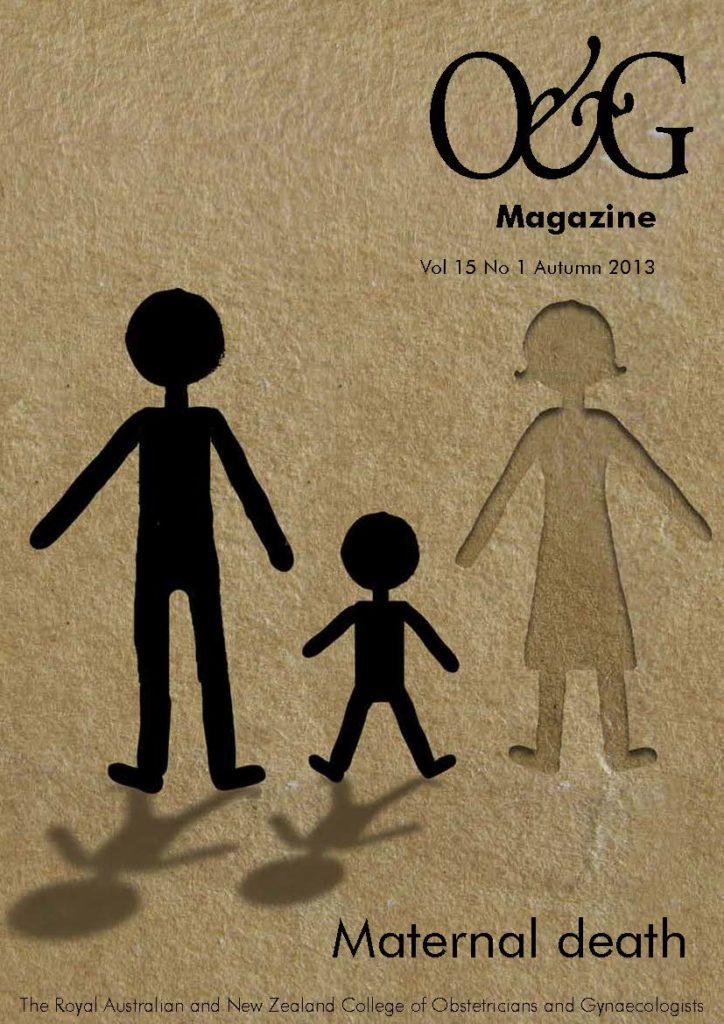The Saving Mothers’ Lives report makes valuable recommendations for general practitioners.
Chapter 14 of the Centre for Maternal and Child Enquiries (CMACE) report, titled Saving Mothers’ Lives, is dedicated to general practice and it makes for interesting reading. The chapter identifies and highlights the key issues for GPs raised by the review of 64 maternal deaths. Although the scope of Australian GPs’ involvement in maternity care is more diverse than in the UK, ranging from minimal through to providing advanced operative procedures, the recommendations in the report remain pertinent and our patients will benefit if we heed their advice. I would recommend all GPs read this chapter, along with the ‘Top 10’ recommendations and the back to basics sections. Consider printing these chapters out and sharing them with colleagues during your next clinical meeting or journal club.
Specific recommendations for general practice
Based on the findings of the review, it is recommended that all GPs should make themselves aware of the clinical features and practice guidelines for the following conditions listed below. Alongside each condition are suggested guidelines:
- Venous thromboembolism and pulmonary embolism:
- Reducing the Risk of Thrombosis and Embolism during Pregnancy and the Puerperium, RCOG1; and
- Clinical Practice Guideline for the Prevention of Venous Thromboembolism in Patients Admitted to Australian Hospitals, NHMRC.2
- Pre-eclampsia and eclampsia:
- Guidelines for the Management of Hypertensive Disorders of Pregnancy, 2008, SOMANZ3; and
- The Management of Hypertensive Disorders During Pregnancy, NICE.4
- Asthma:
- Asthma Management Handbook, National Asthma Council of Australia5 ; and
- British Guideline on the Management of Asthma, British Thoracic Society.6
- Mental health:
- Clinical Practice Guidelines for Depression and Related Disorders – Anxiety, Bipolar Disorder and Puerperal Psychosis
- in the Perinatal Period. Beyond Blue7; and – Antenatal and Postnatal Mental Health, NICE.8
- Obesity:
- Management of Women with Obesity in Pregnancy, RCOG/CMACE.9
Learning points arising from specific causes of death
This section of the chapter examines clinical conditions that resulted in maternal death, explores the role of GPs in each case and makes recommendations designed to improve the standard of care. Below, each condition with the formal recommendations is listed along with some additional general comments.
Venous thromboembolism
- Breathlessness is common in pregnancy, but can be the result of a pulmonary embolism, especially if a woman has risk factors.
Heart rate, Sa02 and spirometry are useful clinical signs. - Making, or excluding, a diagnosis of deep vein thrombosis requires hospital-based investigations i.e. CTPA or V/Q scan.
- Women are at risk of venous thromboembolism (VTE) across all trimesters, with the greatest risk during the postpartum period.
- Severe hyperemesis is a risk factor for VTE, owing to dehydration. Admission for rehydration and thromboprophylaxis may be required if it fails to respond adequately to antiemetics.
- Needle-phobic women can respond to psychological treatment to avoid compromising their obstetric or emergency care.
Eclampsia
- Routine observation of urine and blood pressure should be conducted every time a pregnant woman is seen by a GP, especially if she is feeling unwell.
- Jaundice in a pregnant woman requires immediate investigation and admission.
- Antihypertensives should not be commenced without the involvement of the clinician responsible for overseeing the care of the pregnancy.
- Reduced fetal movements, itching, oedema, haematemesis, thirst, nausea, vomiting, epigastric pain, belching and offensive faeces are all symptoms of severe disease.
- Epigastric pain is a common symptom of significant pre-eclampsia.
- HELLP syndrome may be present before other symptom of pre-eclampsia.
Bleeding or abdominal pain in pregnancy
Ectopic pregnancies commonly present with diarrhoea, vomiting and abdominal pain in the absence of vaginal bleeding. Remember: ‘Every woman is pregnant until proven otherwise.’ Ask about the possibility of pregnancy and, if in any doubt, perform a pregnancy test.
Sepsis
Deaths from genital tract sepsis have risen. Community-acquired group A streptococcal disease is a common cause. Disease can progress rapidly from first symptom to death over 12–24 hours.
- Parenteral penicillin is an appropriate community treatment in a case of puerperal sepsis.
- All pregnant women/recently delivered women should be informed about the risks and signs and symptoms of infection and how to take steps to prevent its transmission.
- All clinicians should be aware of the classic signs and symptoms, and sepsis must be considered in all recently delivered women who feel unwell and/or have pyrexia.
- Sepsis is often insidious in onset. Vital signs should always be checked in women who have any signs or symptoms of possible infection.
Women with sepsis can deteriorate and die rapidly. Abdominal pain, fever and tachycardia are indications for emergency admission for intravenous antibiotics.
GPs should have a lower threshold for performing a throat swab in respiratory tract infections, along with a lower threshold for prescribing antibiotics in pregnancy. The Centor Criteria can be helpful in deciding which women are more likely to be suffering from a Group A streptococcal infection10:
- history of fever;
- tonsillar exudate;
- no cough; and
- tender anterior cervical lymphadenopathy.
Cardiac disease
- Not all chest pain in pregnancy is heartburn: it may be ischaemic, especially if a woman has risk factors.
- Breathlessness in pregnancy may be caused by cardiac conditions and needs to be carefully assessed.
Epilepsy
- Epileptic women of child-bearing age need to be informed of the risks of epilepsy in pregnancy before conception.
- If fits increase or recur in pregnancy, a woman should be referred to a neurologist and be seen within a week.
- Lamotrigine levels need monitoring during pregnancy.
- Pregnant women should be advised to shower rather than bathe and not to lock the bathroom door.
- The Australian Pregnancy Register for Women on Antiepileptic Medication11 is a voluntary national registry of women who become pregnant while taking antiepileptic drugs (AEDs) with the aim to assess the risks to babies exposed to AEDs, to compare the efficacy of various drugs and to observe possible improvements in management practice over time.
Asthma
Assessment of severity of a woman’s asthma is critical and must be communicated to the clinician responsible for pregnancy care. In general, the effect of pregnancy on asthma severity is: one-third improves, one-third is stable and one-third deteriorates. Short-and long-acting beta agonists and inhaled corticosteroids are safe in pregnancy.
Most pregnant women with asthma can be cared for in primary care. Only women with persistent poor control, a history of hospital admission as an adult, respiratory arrest or continuous or frequent courses of oral steroids would require a specialist referral to a respiratory physician during pregnancy.
Psychiatry and substance misuse
Women with a history of psychosis have at least a 50 per cent risk of perinatal recurrence. A family history of psychosis also increases the risk of puerperal psychosis. Care planning for all stages of the pregnancy and postnatal period is critical.
- GPs need a higher level of awareness for women who may be misusing drugs and/or other substances.
- GPs should screen all pregnant women for intimate partner violence.12
- GPs should screen all pregnant women for depression.8
- GPs should be proactive in maintaining contact with women with significant mental health problems, recognising those women may not initiate contact themselves. Book women in for more than the routine schedule of appointments and follow them up if they fail to attend.
A number of suicides or drug-related deaths occurred around the time of child-protection case conferences, suggesting that these are a period of increased risk. Additional support and surveillance through these difficult periods is required, especially if the child is removed.
Management of pre-existing disease
Serious pre-existing medical conditions require consultant involvement in pregnancy care. In the Australian context, this may vary from case discussion or consultation via telemedicine, through to shared care or referring a woman for tertiary care.
Communication
Referral is not treatment. If you are concerned or think an urgent response is required, telephone a senior clinician. However, always back up a fax, email or phone call with a written letter. Write high-quality referrals that specify the current problem and reason for referral, past history, any mental health issues (even if not directly relevant to the presenting problem), all medications she is on or has recently stopped and investigations to date.
GPs and practice staff should know how to access professional translation services rapidly. This is a major recommendation. Australian medical practitioners can register for free interpreting services through the Translating and Interpreting Service (TIS) National.13 For urgent interpreting services call TIS on 131 450.
Conclusions
GPs are committed to providing excellent care; they are experts in managing uncertainty. There is concern GPs are becoming de-skilled in maternity care. GPs need to demonstrate that they are competent in maternity care by updating their knowledge and skills to manage the emergency situations they may have to face.
Although some GPs and registrars no longer consider pregnancy care a routine part of general practice, as primary care specialists we are ideally placed to provide this service and women highly value the continuity of care that is characteristic of general practice. As clinicians, we have a responsibility to practise high-quality medicine. By engaging in continuing professional development, being familiar with current evidence-based clinical practice guidelines and reflecting on reports by organisations such as CMACE, we will be able to provide high-quality maternity care to our pregnant patients into the future.
References
- Royal College of Obstetrics and Gynaecology. Reducing the Risk of Thrombosis and Embolism during Pregnancy and the Puerperium Green-top Guideline 37a. London: RCOG Press, 2009 [http://www.rcog.org.uk/womens-health/clinical-guidance/reducing-risk-of-thrombosis-greentop37a]. Accessed 26 January 2012.
- National Health and Medical Research Council. Clinical practice guideline for the prevention of venous thromboembolism (deep vein thrombosis and pulmonary embolism) in patients admitted to Australian hospitals. Melbourne: National Health and Medical Research Council; 2009.
- Society of Obstetric Medicine of Australia and New Zealand. Guidelines for the Management of Hypertensive Disorders of Pregnancy 2008. http://www.somanz.org/ pdfs/somanz_ guidelines_2008.pdf . Accessed 26 January 2012.
- National Collaborating Centre for Women’s and Children’s Health. Hypertension in Pregnancy: The Management of Hypertension During Pregnancy. National Institute for Clinical Excellence. Clinical Guideline 107. London: RCOG, August 2010[guidance.nice.org.uk/CG107/]. Accessed 26 January 2012.
- National Asthma Council Australia. Asthma Management Handbook. 2006. Melbourne, 2006.
- British Thoracic Society/Scottish Intercollegiate Guidelines Network. British Guideline on the Management of Asthma. London: BTS, 2009.
- beyondblue (2011) Clinical practice guidelines for depression
and related disorders – anxiety, bipolar disorder and puerperal psychosis – in the perinatal period. A guideline for primary care health professionals. Melbourne: beyondblue: the national depression initiative. - National Collaborating Centre for Women’s and Children’s Health. Antenatal and Postnatal Mental Health. Clinical Management and Service Guidance. National Institute for Clinical Excellence. Clinical Guideline 45. London: NICE, 2007 [guidance.nice.org.uk/CG45/nice-guidance/pdf/English]. Accessed 26 January 2012.
- Centre for Maternal and Child Enquires and the Royal College of Obstetricians and Gynaecologists. CMACE/RCOG Joint Guideline: Management of Women with Obesity in Pregnancy. London: CMACE/RCOG, 2010.
- 10 Cooper RJ, Hoffman JR, Bartlett JG, Besser RE, Gonzales R, Hickner JM, et al. Principles of appropriate antibiotic use for acute pharyngitis in adults: background. Ann Intern Med 2001;134:509–17.
- Epilepsy Australia. http://www.epilepsyaustralia.net/Australian Pregnancy_Register /Australian_Pregnancy_Register.aspx. Accessed d26 January 2012.
- The Royal Australian College of General Practitioners. Abuse and violence: working with our patients in general practice. South Melbourne: the RACGP, 2008.






Leave a Reply